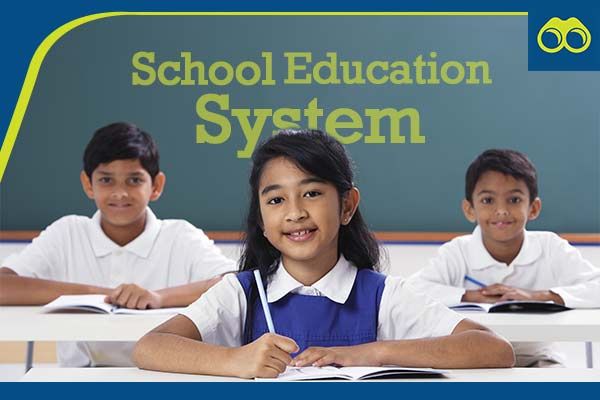Category: Recommendation

India's school education system is one of the largest and most complex in the world, catering to millions of students from diverse backgrounds. It plays a crucial role in shaping young minds and preparing them for the challenges of the future.
However, like any vast and diverse system, the Indian education landscape faces numerous challenges and offers unique opportunities. In this blog, Skoodos will conduct a detailed analysis of the school education system in India, exploring its structure, key features, strengths, weaknesses, and potential areas of improvement.
The school education system in India is divided into several stages, with each serving a specific age group and educational level. The primary stages are as follows:
This informal phase caters to children between the ages of 3 to 6 years and focuses on developing essential skills through play-based learning.
Primary education covers classes 1 to 5, and its main objective is to provide a foundational education in languages, mathematics, science, and social studies.
Upper primary education comprises classes 6 to 8, where students delve deeper into subjects and explore more complex concepts.
Secondary education includes classes 9 to 10, and students take board exams at the end of class 10, which serve as a crucial milestone in their academic journey.
This stage includes classes 11 to 12, where students can choose specific streams, such as Science, Commerce, or Humanities, based on their career aspirations.
India's vast cultural diversity is reflected in its education system, with various languages and regional curricula being used across states. This diversity celebrates the nation's rich heritage and ensures that students receive education in their native tongues.
The Indian education system operates under both central and state boards of education. The Central Board of Secondary Education (CBSE) and the Indian Certificate of Secondary Education (ICSE) are two prominent central boards, while each state has its respective State Board of Education.
Indian education places significant emphasis on examinations, particularly board exams, which are considered crucial for determining students' academic performance and future prospects.
India has made strides towards promoting inclusive education, striving to provide quality education for children with disabilities and those belonging to marginalized communities.
India's education system caters to an extensive talent pool, producing numerous bright minds in various fields like science, technology, medicine, literature, and arts.
Indian students have consistently showcased exceptional skills in international academic competitions, earning global recognition and respect for their talents.
The Indian education system emphasizes Science, Technology, Engineering, and Mathematics (STEM) education, fostering a strong foundation for students pursuing careers in these fields.
India's system of competitive entrance examinations for higher education institutions encourages students to strive for excellence and ensures that the best talents get admitted to prestigious colleges and universities.
One of the significant criticisms faced by the Indian education system is the prevalence of rote learning, which focuses on memorization rather than understanding and critical thinking.
The curriculum in some schools is often outdated and not aligned with the needs of the modern world, neglecting essential skills like problem-solving, communication, and digital literacy.
Despite efforts to promote inclusive education, there are significant disparities in access to quality education, with rural and economically disadvantaged areas often lacking adequate facilities and resources.
The intense focus on exams and competition can lead to tremendous pressure on students, resulting in mental health issues and high rates of stress and anxiety.
Updating the curriculum to incorporate more practical and application-based learning methods can foster a deeper understanding of subjects and reduce reliance on rote learning.
Enhancing teacher training programs and providing continuous professional development can improve the quality of education imparted to students.
Leveraging technology to supplement traditional teaching methods can make education more engaging and accessible to a broader audience, especially in remote areas.
Introducing skill development programs from an early age can equip students with the necessary tools to succeed in a rapidly evolving job market.
Unlocking the Potential of India's School Education System:
Paving the Path to a Brighter Future. The Indian school education system has its share of strengths and weaknesses. While it has produced countless accomplished individuals, it also faces challenges that must be addressed to ensure an inclusive, progressive, and relevant education for all students.
By fostering innovation, embracing modern teaching methodologies, and prioritizing the holistic development of students, India's education system can transform into a powerhouse of knowledge, preparing its young citizens to excel in an ever-changing world.
 Blog: Recently Added
Blog: Recently AddedDeciding on a school board is a decision that has a great deal of financial and emotional impact on...
Searching for an ideal early learning institution in a busy metropolitan city can indeed seem challe...
The education system in India is going through a dramatic transformative process. The traditional ch...
The Indian education system is going through massive changes. In the past, success in academics was...
The education of children born after 2010, commonly known by the name of Gen Alpha students--is...
Recent years have seen the academic standard in India has gone beyond simply scoring high on board e...
The choice of the ideal school is among the most significant parental decisions that affect their ch...
Sending a child to school is one of the most important and stressful activities a parent must do in...
Selecting the best school for your child is among the most significant choices parents can make for...
Choosing a good school is one of the toughest choices that a parent has to make, and now this entire...

